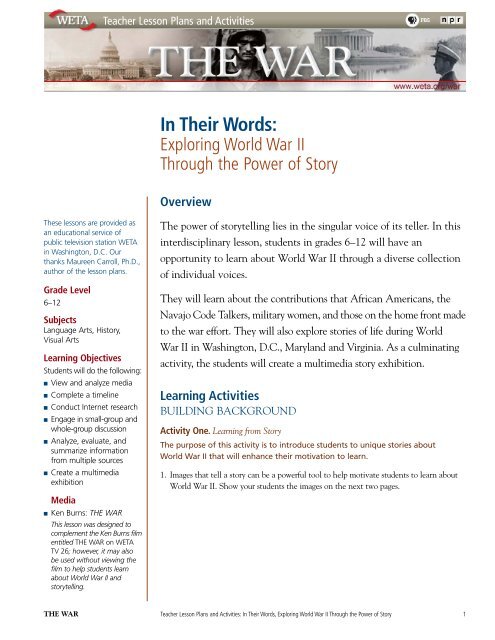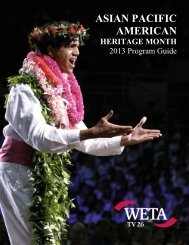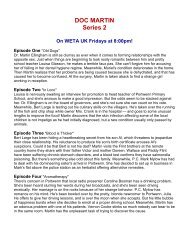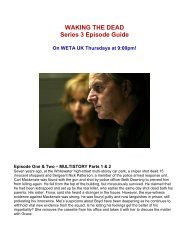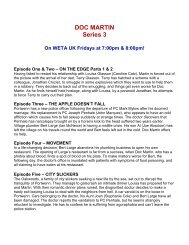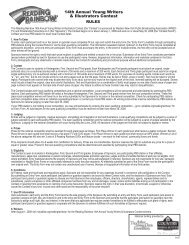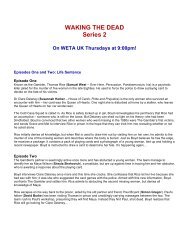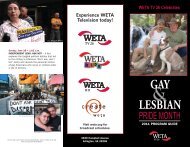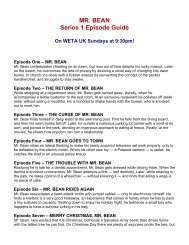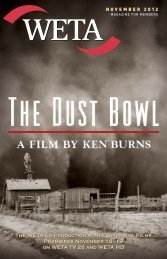Download lesson plan (749KB PDF) - WETA
Download lesson plan (749KB PDF) - WETA
Download lesson plan (749KB PDF) - WETA
Create successful ePaper yourself
Turn your PDF publications into a flip-book with our unique Google optimized e-Paper software.
Teacher Lesson Plans and Activities<br />
In Their Words:<br />
Exploring World War II<br />
Through the Power of Story<br />
Overview<br />
These <strong>lesson</strong>s are provided as<br />
an educational service of<br />
public television station <strong>WETA</strong><br />
in Washington, D.C. Our<br />
thanks Maureen Carroll, Ph.D.,<br />
author of the <strong>lesson</strong> <strong>plan</strong>s.<br />
Grade Level<br />
6–12<br />
Subjects<br />
Language Arts, History,<br />
Visual Arts<br />
Learning Objectives<br />
Students will do the following:<br />
■ View and analyze media<br />
■ Complete a timeline<br />
■ Conduct Internet research<br />
■ Engage in small-group and<br />
whole-group discussion<br />
■ Analyze, evaluate, and<br />
summarize information<br />
from multiple sources<br />
■ Create a multimedia<br />
exhibition<br />
Media<br />
■ Ken Burns: THE WAR<br />
This <strong>lesson</strong> was designed to<br />
complement the Ken Burns film<br />
entitled THE WAR on <strong>WETA</strong><br />
TV 26; however, it may also<br />
be used without viewing the<br />
film to help students learn<br />
about World War II and<br />
storytelling.<br />
The power of storytelling lies in the singular voice of its teller. In this<br />
interdisciplinary <strong>lesson</strong>, students in grades 6–12 will have an<br />
opportunity to learn about World War II through a diverse collection<br />
of individual voices.<br />
They will learn about the contributions that African Americans, the<br />
Navajo Code Talkers, military women, and those on the home front made<br />
to the war effort. They will also explore stories of life during World<br />
War II in Washington, D.C., Maryland and Virginia. As a culminating<br />
activity, the students will create a multimedia story exhibition.<br />
Learning Activities<br />
BUILDING BACKGROUND<br />
Activity One. Learning from Story<br />
The purpose of this activity is to introduce students to unique stories about<br />
World War II that will enhance their motivation to learn.<br />
1. Images that tell a story can be a powerful tool to help motivate students to learn about<br />
World War II. Show your students the images on the next two pages.<br />
THE WAR Teacher Lesson Plans and Activities: In Their Words, Exploring World War II Through the Power of Story 1
Teacher Lesson Plans and Activities<br />
Ask the students to brainstorm ideas about what they think this quilt represents.<br />
Then share with your students the information below about the quilt’s origin on page 3.<br />
THE WAR Teacher Lesson Plans and Activities: In Their Words, Exploring World War II Through the Power of Story 2
Teacher Lesson Plans and Activities<br />
THE WAR Teacher Lesson Plans and Activities: In Their Words, Exploring World War II Through the Power of Story 3
Teacher Lesson Plans and Activities<br />
2. Show the students the following image of a Virginia boy pulling down a blackout shade<br />
during World War II at<br />
http://www.vahistory.org/WWII/image_archive/image.phpimage_id=857&page=<br />
Ask the students to brainstorm ideas about what the boy is doing and why he is doing it.<br />
3. Tell the students that they are going to listen to two stories of women who lived during<br />
World War II. First, listen to the audio recording of World War II Army nurse Oneida<br />
Miller Stuart’s experiences with racist patients and prisoners of war from Veterans<br />
History Project at<br />
http://lcweb2.loc.gov/diglib/vhp-stories/loc.natlib.afc2001001.04850/.<br />
(Click on audio excerpt entitled “Dealing with racist patients and prisoners of war.”)<br />
Then read the story below aloud to your class.<br />
A young boy does his part to<br />
defend the homefront by pulling<br />
down a blackout shade<br />
Image courtesy of National Archives and<br />
Records Administration.<br />
Jean Devlin was eleven years old when the United States entered<br />
World War II. She lived in Sag Harbor, a small town located in the<br />
east end of Long Island, New York.<br />
Our whole town had to have black out shades and they had to<br />
be down as soon as it got dark. My friend Audrey lived two<br />
blocks away, and we would signal to each other to say goodnight.<br />
We would lift it up and down a few times before the shade had to<br />
go down for the night.<br />
There was a group of volunteer men who patrolled the streets at<br />
night to see if there were any <strong>plan</strong>es coming over us. My Uncle<br />
Johnny was in this group.<br />
Oneida Miller Stuart<br />
Everything was rationed—sugar, coffee, meat. When you ran out<br />
of ration tickets, you could no longer get anything. Sometimes we<br />
traded with other families depending on what we needed. The<br />
butter came in a white stick with a yellow disk that you had to<br />
work into the stick of butter to make it look yellow-like you<br />
expected. You couldn't use silk stockings anymore—all the material<br />
had to go to the parachute makers.<br />
Lead a class discussion based on students’ responses to the two stories. Use the following<br />
questions to guide the discussion:<br />
■ What were you able to learn about World War II from these stories<br />
■ What were you able to learn about Oneida Miller Stuart and Jean Devlin from<br />
these stories<br />
■ How did the stories make you feel<br />
■ What were you able to learn about racism from Oneida’s story<br />
■ What were you able to learn about life on the home front from Jean Devlin’s story<br />
■ How do you think it must have felt to be a child during World War II<br />
■ How do you think it must have felt to be an Army nurse during World War II<br />
■ How do you think life is different for children experiencing war today compared<br />
to World War II<br />
THE WAR Teacher Lesson Plans and Activities: In Their Words, Exploring World War II Through the Power of Story 4
Teacher Lesson Plans and Activities<br />
Activity Two. Pieces of Time<br />
The purpose of this activity is to provide students with background information<br />
about the key events of World War II from 1939–1945.<br />
1. Divide the class into four groups. Hang a large piece of butcher paper in the classroom<br />
and divide it into seven sections. Label the sections 1939, 1940, 1941, 1942, 1943, 1944<br />
and 1945.<br />
Teacher Note: You may also use the panels of a blackboard.<br />
2. Tell the students that they are going to complete a timeline on World War II. Give each<br />
group a copy of the “World War II Timeline” handout.<br />
3. Ask each group to fill out its assigned portion of the handout. When the students have<br />
finished, have them list two or three key events under the correct year on the butcher<br />
paper panels so that the entire class may view all the time periods from 1939–1945.<br />
Have the groups briefly explain to the entire class the key events they record on the chart.<br />
STEPS<br />
Activity One. Jigsaw Learning<br />
The purpose of this activity is for students to conduct small-group collaborative<br />
research on a specific topic of World War II history, and share the results with the<br />
whole class in a multimedia presentation.<br />
1. Divide the class into four groups. Tell the students that they are going to create a class<br />
presentation based upon stories of World War II.<br />
2. Give each group a copy of the handout entitled “World War Two Story Project Planner.”<br />
You may wish to review the steps on the handout with your students and clarify any<br />
questions. The handout is designed to help students create their class presentation.<br />
It begins with a resource collection that contains information about women who served<br />
in World War II, African Americans who served in World War II, Native Americans<br />
roles in World War II, and Japanese Americans’ experiences in World War II. Discuss<br />
with your students the importance of information that we can gain from primary sources.<br />
The resources listed below appear on the student’s handouts.<br />
The Women of World War II<br />
The Library of Congress Rosie the Riveter: Real Women Workers in World War II<br />
http://www.vahistory.org/WWII/<br />
American Merchant Marine at War<br />
http://www.usmm.org/women.html<br />
The Library of Congress Local Legacies: Fort Lee, Virginia & The Legacy of Army Women<br />
http://lcweb2.loc.gov/cocoon/legacies/VA/200003605.html<br />
The National Archives<br />
http://www.archives.gov/exhibits/powers_of_persuasion/its_a_womans_war_too/its_a_<br />
womans_war_too.html<br />
THE WAR Teacher Lesson Plans and Activities: In Their Words, Exploring World War II Through the Power of Story 5
Teacher Lesson Plans and Activities<br />
PBS American Experience: Fly Girls<br />
http://www.pbs.org/wgbh/amex/flygirls/<br />
Primary Source Cornelia Fort American WWII Pilot<br />
http://www.pbs.org/wgbh/amex/flygirls/filmmore/reference/primary/lettersarticles01.html<br />
Women in Military Service for America Memorial Foundation<br />
http://www.womensmemorial.org/Education/BBH1998.html#6<br />
The Library of Congress<br />
http://lcweb2.loc.gov/cgi-bin/query/ipp/fsaall:@filreq(@field(NUMBER+@band(fsac+1a35337))+<br />
@field(COLLID+fsac)):displayType=1:m856sd=fsac:m856sf<br />
Brown University “What Did You Do in the War, Grandma”<br />
http://www.stg.brown.edu/projects/WWII_Women/tocCS.html<br />
African Americans in World War II<br />
National Public Radio “We Were There”<br />
http://www.npr.org/templates/story/story.phpstoryId=1917020<br />
Virginia Historical Society: The Civil Rights Movement in Virginia Turning Point: World War II<br />
http://www.vahistorical.org/civilrights/ww2.htm<br />
American Memory<br />
http://memory.loc.gov/ammem/aaohtml/exhibit/aopart8.html<br />
African American Freedom Fighters<br />
http://www.liu.edu/cwis/cwp/library/aaffsfl.htm#WWTWO<br />
(Click on WWII)<br />
The National Archives<br />
Pictures of African Americans During WWII<br />
http://www.archives.gov/research/african-americans/ww2-pictures/index.html<br />
The Library of Congress Experiencing War: Stories from the Veterans History Project<br />
Rutherford Vincent Brice<br />
http://lcweb2.loc.gov/diglib/vhp-stories/loc.natlib.afc2001001.05397/<br />
United States Merchant Marines<br />
http://www.usmm.org/african-americans.html<br />
African American Odyssey<br />
http://memory.loc.gov/ammem/aaohtml/exhibit/aopart8.html<br />
Japanese Americans in World War II<br />
The National Archives Japanese Relocation and Internment During World War II<br />
http://www.archives.gov/research/alic/reference/military/japanese-internment.html<br />
Smithsonian Institution<br />
http://americanhistory.si.edu/perfectunion/experience/index.html<br />
University of Utah<br />
http://www.lib.utah.edu/spc/photo/9066/9066.htm<br />
The Japanese American Archival Collection<br />
http://library.csus.edu/collections/jaac/<br />
Densho.org<br />
www.densho.org<br />
THE WAR Teacher Lesson Plans and Activities: In Their Words, Exploring World War II Through the Power of Story 6
Teacher Lesson Plans and Activities<br />
Native Americans in World War II<br />
Defense Link<br />
http://www.defenselink.mil/specials/nativeamerican01/wwii.html<br />
Native Americans in World War II<br />
http://www.shsu.edu/~his_ncp/NAWWII.html<br />
Department of the Navy: Navajo Code Talkers<br />
http://www.history.navy.mil/faqs/faq61-2.htm<br />
Military Contributions of Native Americans<br />
http://library.thinkquest.org/TQ0312140/ThinkQuest/Patty%20Jo/Native%20Americans%20in%20<br />
the%20Military.htm<br />
Latinos & Latinas in World War II<br />
The University of Texas at Austin War Stories<br />
http://www.utexas.edu/features/archive/2004/history.html<br />
http://utopia.utexas.edu/explore/latino/narratives/v4n2index.html<br />
(Scroll to “The Stories’)<br />
The Hispanic Experience: Hispanics in Military Service<br />
http://www.houstonculture.org/hispanic/memorial.html<br />
Latino Advocates<br />
http://www.latinoadvocates.org/Foreword2.htm<br />
Latino Perspectives<br />
http://www.latinopm.com/Latino-Perspectives-Magazine/July-2007/Behind-the-camera/<br />
Organization of American Historians<br />
“Many Americas in the Shadow of the Capitol: Latinos in Washington, D.C.”<br />
http://www.oah.org/pubs/nl/2006feb/cadaval.html<br />
AARP Segunda Juventad World War II Veterans<br />
http://www.aarpsegundajuventud.org/english/issues/2002-oct/1.vets.htm<br />
Virginia, Maryland & Washington, D.C. Resources<br />
<strong>WETA</strong><br />
http://www.weta.org/war/page_id=9#video<br />
Maryland Public Television<br />
http://www.mpt.org/thewar/maryland/mdsuccess.html<br />
The Library of Congress Local Legacies: Fort Lee, Virginia & The Legacy of Army Women<br />
http://lcweb2.loc.gov/cocoon/legacies/VA/200003605.html<br />
University of Virginia<br />
Letter from a Nurse<br />
http://www.healthsystem.virginia.edu/internet/library/historical/uva_hospital/8evac/<br />
Laurel Historical Society<br />
http://www.laurelhistory.org/exhibits_ww2.html<br />
Cradle of Victory Trail<br />
http://visitnorthernvirginia.com/Maps/cradle_of_victory_trail<br />
The George C. Marshall Museum<br />
http://www.marshallfoundation.org/museum/index.html<br />
THE WAR Teacher Lesson Plans and Activities: In Their Words, Exploring World War II Through the Power of Story 7
Teacher Lesson Plans and Activities<br />
Arlington Historical Museum<br />
http://www.arlingtonhistoricalsociety.org/learn/snapshots/military_hist_army-navy.asp<br />
(Scroll to “On the homefront”)<br />
Teacher Note: This <strong>lesson</strong> would be greatly enhanced if you could invite a World War II<br />
veteran to speak with your class.<br />
3. Provide class time for the students to develop their multimedia presentations.<br />
4. Invite others in the school and community to view students’ multimedia exhibitions.<br />
Extension Activities<br />
Activity One. The Music of World War II<br />
1. Ask your students to explore the music of World War II at<br />
http://www.umkc.edu/lib/spec-col/ww2/WarNews/index.htm<br />
on “G.I. Jive” and “Boogie Woogie Bugle Boys.”<br />
2. Ask the class to discuss how music can tell a story about a particular place and time, and<br />
how the music they heard tells a story about World War II.<br />
Activity Two: The Victory Garden<br />
1. As a class, view the <strong>WETA</strong> video that showcases the Washington D.C. Victory Garden at<br />
http://www.weta.com/community/neighborhoods/gloverpark/<br />
You might also wish to take your class on the U.S. Arboretum Youth Victory Garden tour.<br />
2. Ask your students why they think victory gardens were an important part of the home<br />
front effort during World War II.<br />
Activity Three: Women Journalists, Photographers & Broadcasters<br />
1. Have your students read about the role that women journalists, photographers and<br />
broadcasters played in WWII at<br />
http://www.loc.gov/exhibits/wcf/<br />
2. Ask the students to create brief presentations to share what they have learned with<br />
their classmates.<br />
THE WAR Teacher Lesson Plans and Activities: In Their Words, Exploring World War II Through the Power of Story 8
Teacher Lesson Plans and Activities<br />
National Education Standards<br />
http://www.mcrel.org<br />
READING<br />
Standard 7.<br />
Uses reading skills and strategies to understand and interpret a variety of informational texts<br />
http://www.mcrel.org/compendium/standardDetails.aspsubjectID=7&standardID=7<br />
Level III (Grades 6–8)<br />
1. Uses reading skills and strategies to understand a variety of informational texts<br />
(e.g., electronic texts; textbooks; biographical sketches; directions; essays; primary source<br />
historical documents, including letters and diaries; print media, including editorials,<br />
news stories, periodicals, and magazines; consumer, workplace, and public documents,<br />
including catalogs, technical directions, procedures, and bus routes)<br />
3. Summarizes and paraphrases information in texts (e.g., arranges information in<br />
chronological, logical, or sequential order; conveys main ideas, critical details, and<br />
underlying meaning; uses own words or quoted materials; preserves author’s perspective<br />
and voice)<br />
4. Uses new information to adjust and extend personal knowledge base<br />
Level IV (Grades 9–12)<br />
1. Uses reading skills and strategies to understand a variety of informational texts (e.g.,<br />
textbooks, biographical sketches, letters, diaries, directions, procedures, magazines,<br />
essays, primary source historical documents, editorials, news stories, periodicals, catalogs,<br />
job-related materials, schedules, speeches, memoranda, public documents, maps)<br />
WRITING<br />
Standard 4.<br />
Gathers and uses information for research purposes<br />
http://www.mcrel.org/compendium/standardDetails.aspsubjectID=7&standardID=4<br />
Level III (Grades 6–8)<br />
3. Uses a variety of resource materials to gather information for research topics<br />
(e.g., magazines, newspapers, dictionaries, schedules, journals, phone directories, globes,<br />
atlases, almanacs, technological sources)<br />
5. Organizes information and ideas from multiple sources in systematic ways (e.g., time<br />
lines, outlines, notes, graphic representations)<br />
Level IV (Grades 9–12)<br />
2. Uses a variety of print and electronic sources to gather information for research topics<br />
(e.g., news sources such as magazines, radio, television, newspapers; government<br />
publications; microfiche; telephone information services; databases; field studies;<br />
speeches; technical documents; periodicals; Internet)<br />
THE WAR Teacher Lesson Plans and Activities: In Their Words, Exploring World War II Through the Power of Story 9
Teacher Lesson Plans and Activities<br />
HISTORY<br />
Standard 2.<br />
Understands the historical perspective<br />
http://www.mcrel.org/compendium/standardDetails.aspsubjectID=3&standardID=2<br />
Level III (Grades 5–6)<br />
2. Understands that specific individuals had a great impact on history<br />
5. Understands that specific decisions and events had an impact on history<br />
Level IV (Grades 7–8)<br />
2. Analyzes the influence specific ideas and beliefs had on a period of history<br />
6. Knows different types of primary and secondary sources and the motives, interests, and<br />
bias expressed in them (e.g., eyewitness accounts, letters, diaries, artifacts, photos;<br />
magazine articles, newspaper accounts, hearsay)<br />
Level IV (Grades 9–12)<br />
1. Analyzes the values held by specific people who influenced history and the role their<br />
values played in influencing history<br />
10. Understands how the past affects our private lives and society in general<br />
11. Knows how to perceive past events with historical empathy<br />
VISUAL ARTS<br />
Level III (Grades 5–8)<br />
2. Understands what makes various organizational structures effective (or ineffective) in<br />
the communication of ideas<br />
3. Knows how the qualities of structures and functions of art are used to improve<br />
communication of one’s ideas<br />
Level IV (Grades 9–12)<br />
1. Understands how the characteristics and structures of art are used to accomplish<br />
commercial, personal, communal, or other artistic intentions<br />
WORKING WITH OTHERS<br />
Standard 1.<br />
Contributes to the overall effort of a group<br />
http://www.mcrel.org/compendium/Benchmark.aspSubjectID=22&StandardID=1<br />
Level IV (Grade K-12)<br />
THE WAR Teacher Lesson Plans and Activities: In Their Words, Exploring World War II Through the Power of Story 9
Activity<br />
World War II Story Project Planner<br />
Your task is to create a multimedia presentation based on what you have learned about<br />
World War II through the power of stories. Your presentation must contain the following<br />
elements:<br />
■ Background Information on World War II<br />
■ Information about either women, African Americans, Native Americans, Latinos<br />
& Latinas, or Japanese Americans during World War II<br />
■ Information about local World War II stories from Virginia, Washington, D.C.<br />
and Maryland<br />
Be creative! You may wish to create a memory box, a podcast, a slide show, a music video, a<br />
public service announcement, a skit, a mural, or an idea of your own.<br />
Step One.<br />
The first step in your project is to conduct research. You may begin by using the<br />
following resources to learn about World War II.<br />
The Women of World War II<br />
The Library of Congress Rosie the Riveter: Real Women Workers in World War II<br />
http://www.vahistory.org/WWII/<br />
American Merchant Marine at War<br />
http://www.usmm.org/women.html<br />
The Library of Congress Local Legacies: Fort Lee, Virginia & The Legacy of Army Women<br />
http://lcweb2.loc.gov/cocoon/legacies/VA/200003605.html<br />
The National Archives<br />
http://www.archives.gov/exhibits/powers_of_persuasion/its_a_womans_war_too/its_a_<br />
womans_war_too.html<br />
PBS American Experience: Fly Girls<br />
http://www.pbs.org/wgbh/amex/flygirls/<br />
Primary Source Cornelia Fort American WWII Pilot<br />
http://www.pbs.org/wgbh/amex/flygirls/filmmore/reference/primary/lettersarticles01.html<br />
Women in Military Service for America Memorial Foundation<br />
http://www.womensmemorial.org/Education/BBH1998.html#6<br />
The Library of Congress<br />
http://lcweb2.loc.gov/cgi-bin/query/ipp/fsaall:@filreq(@field(NUMBER+@band(fsac+1a35337))+<br />
@field(COLLID+fsac)):displayType=1:m856sd=fsac:m856sf<br />
THE WAR Activity: World War II Story Project Planner 1
Brown University “What Did You Do in the War, Grandma”<br />
http://www.stg.brown.edu/projects/WWII_Women/tocCS.html<br />
African Americans in World War II<br />
National Public Radio “We Were There”<br />
http://www.npr.org/templates/story/story.phpstoryId=1917020<br />
Virginia Historical Society: The Civil Rights Movement in Virginia Turning Point: World War II<br />
http://www.vahistorical.org/civilrights/ww2.htm<br />
American Memory<br />
http://memory.loc.gov/ammem/aaohtml/exhibit/aopart8.html<br />
African American Freedom Fighters<br />
http://www.liu.edu/cwis/cwp/library/aaffsfl.htm#WWTWO<br />
(Click on WWII)<br />
The National Archives<br />
Pictures of African Americans During WWII<br />
http://www.archives.gov/research/african-americans/ww2-pictures/index.html<br />
The Library of Congress Experiencing War: Stories from the Veterans History Project<br />
Rutherford Vincent Brice<br />
http://lcweb2.loc.gov/diglib/vhp-stories/loc.natlib.afc2001001.05397/<br />
United States Merchant Marines<br />
http://www.usmm.org/african-americans.html<br />
African American Odyssey<br />
http://memory.loc.gov/ammem/aaohtml/exhibit/aopart8.html<br />
Japanese Americans in World War II<br />
The National Archives Japanese Relocation and Internment During World War II<br />
http://www.archives.gov/research/alic/reference/military/japanese-internment.html<br />
Smithsonian Institution<br />
http://americanhistory.si.edu/perfectunion/experience/index.html<br />
University of Utah<br />
http://www.lib.utah.edu/spc/photo/9066/9066.htm<br />
The Japanese American Archival Collection<br />
http://library.csus.edu/collections/jaac/<br />
Densho.org<br />
www.densho.org<br />
Native Americans in World War II<br />
Defense Link<br />
http://www.defenselink.mil/specials/nativeamerican01/wwii.html<br />
Native Americans in World War II<br />
http://www.shsu.edu/~his_ncp/NAWWII.html<br />
Department of the Navy: Navajo Code Talkers<br />
http://www.history.navy.mil/faqs/faq61-2.htm<br />
Military Contributions of Native Americans<br />
http://library.thinkquest.org/TQ0312140/ThinkQuest/Patty%20Jo/Native%20Americans%20in%20<br />
the%20Military.htm<br />
THE WAR Activity: World War II Story Project Planner 2
Latinos & Latinas in World War II<br />
The University of Texas at Austin War Stories<br />
http://www.utexas.edu/features/archive/2004/history.html<br />
http://utopia.utexas.edu/explore/latino/narratives/v4n2index.html<br />
(Scroll to “The Stories)<br />
The Hispanic Experience: Hispanics in Military Service<br />
http://www.houstonculture.org/hispanic/memorial.html<br />
Latino Advocates<br />
http://www.latinoadvocates.org/Foreword2.htm<br />
Latino Perspectives<br />
http://www.latinopm.com/Latino-Perspectives-Magazine/July-2007/Behind-the-camera/<br />
Organization of American Historians<br />
“Many Americas in the Shadow of the Capitol: Latinos in Washington, D.C.”<br />
http://www.oah.org/pubs/nl/2006feb/cadaval.html<br />
AARP Segunda Juventad World War II Veterans<br />
http://www.aarpsegundajuventud.org/english/issues/2002-oct/1.vets.htm<br />
Virginia, Maryland & Washington, D.C. Resources<br />
<strong>WETA</strong><br />
http://www.weta.org/war/page_id=9#video<br />
Maryland Public Television<br />
http://www.mpt.org/thewar/maryland/mdsuccess.html<br />
The Library of Congress Local Legacies: Fort Lee, Virginia & The Legacy of Army Women<br />
http://lcweb2.loc.gov/cocoon/legacies/VA/200003605.html<br />
University of Virginia<br />
Letter from a Nurse<br />
http://www.healthsystem.virginia.edu/internet/library/historical/uva_hospital/8evac/<br />
Laurel Historical Society<br />
http://www.laurelhistory.org/exhibits_ww2.html<br />
Cradle of Victory Trail<br />
http://visitnorthernvirginia.com/Maps/cradle_of_victory_trail<br />
The George C. Marshall Museum<br />
http://www.marshallfoundation.org/museum/index.html<br />
Arlington Historical Museum<br />
http://www.arlingtonhistoricalsociety.org/learn/snapshots/military_hist_army-navy.asp<br />
(Scroll to “On the homefront”)<br />
THE WAR Activity: World War II Story Project Planner 3
Step Two.<br />
As a group, brainstorm ideas for your multimedia exhibition. Write your ideas in the<br />
space below.<br />
Step Three.<br />
Discuss the group’s ideas, and choose a topic for the multimedia exhibition.<br />
Write your topic in the space below.<br />
Step Four.<br />
Decide on the format of your multimedia exhibition. You may wish to create a podcast,<br />
create a brief film, create a photographic display, create a music video, a mural or any<br />
other ideas you may choose about how to best showcase the stories of World War II.<br />
Describe your <strong>plan</strong> in the space below.<br />
THE WAR Activity: World War II Story Project Planner 4
Step Five.<br />
Decide what you will include in your multimedia exhibition. List all the components in<br />
the space below.<br />
Step Six.<br />
Share your <strong>plan</strong> with another group. In the space below, write any changes or additions<br />
you may include after listening to the group’s feedback.<br />
THE WAR Activity: World War II Story Project Planner 5
Activity<br />
World War II Timeline<br />
Group One<br />
1939 and 1940<br />
Each group must write a brief summary of its assigned portion of the World War II timeline<br />
covering the dates 1939–1945. You may use the resources below to find information.<br />
■<br />
American Experience<br />
http://www.pbs.org/wgbh/amex/bulge/timeline/index.html<br />
Group Two<br />
1941 and 1942<br />
■<br />
Thinkquest The Home Front<br />
http://library.thinkquest.org/15511/timeline/index.htm<br />
Group Two<br />
1943 and 1944<br />
You may also use library reference materials to complete your summaries.<br />
1939 and 1940 | Group One<br />
THE WAR Activity: World War II Timeline 1
Activity<br />
World War II Timeline<br />
Group One<br />
1939 and 1940<br />
Each group must write a brief summary of its assigned portion of the World War II timeline<br />
covering the dates 1939–1945. You may use the resources below to find information.<br />
■<br />
American Experience<br />
http://www.pbs.org/wgbh/amex/bulge/timeline/index.html<br />
Group Two<br />
1941 and 1942<br />
■<br />
Thinkquest The Home Front<br />
http://library.thinkquest.org/15511/timeline/index.htm<br />
Group Two<br />
1943 and 1944<br />
You may also use library reference materials to complete your summaries.<br />
1941 and 1942 | Group Two<br />
THE WAR Activity: World War II Timeline 2
Activity<br />
World War II Timeline<br />
Group One<br />
1939 and 1940<br />
Each group must write a brief summary of its assigned portion of the World War II timeline<br />
covering the dates 1939–1945. You may use the resources below to find information.<br />
■<br />
American Experience<br />
http://www.pbs.org/wgbh/amex/bulge/timeline/index.html<br />
Group Two<br />
1941 and 1942<br />
■<br />
Thinkquest The Home Front<br />
http://library.thinkquest.org/15511/timeline/index.htm<br />
Group Two<br />
1943 and 1944<br />
You may also use library reference materials to complete your summaries.<br />
1943 and 1944 | Group Three<br />
THE WAR Activity: World War II Timeline 3
Teacher Lesson Plans and Activities<br />
Multimedia Storytelling Exhibition<br />
Rubric<br />
Task Excellent Good Needs improvement<br />
Brainstorm ideas<br />
The group brainstormed<br />
at least 10 ideas for the<br />
multimedia exhibit.<br />
The group brainstormed<br />
at least 7 ideas for the<br />
multimedia exhibit<br />
The group was able to<br />
brainstorm fewer than 7<br />
ideas for the multimedia<br />
exhibit.<br />
Discuss ideas &<br />
select topic<br />
The group was highly<br />
effective in discussing<br />
ideas and working<br />
together to choose a topic<br />
for the multimedia exhibition.<br />
The group was somewhat<br />
effective in discussing<br />
ideas and working<br />
together to choose a topic<br />
for the multimedia exhibition.<br />
The group was not able<br />
to work effectively<br />
together to discuss ideas<br />
and to choose a topic for the<br />
multimedia exhibition.<br />
Select a format<br />
& develop<br />
components<br />
The group did an excellent<br />
job selecting a format and<br />
developing ideas for the<br />
multimedia presentation.<br />
The group did a good job<br />
selecting a format and<br />
developing ideas for the<br />
multimedia presentation.<br />
The group did not do an<br />
effective job in selecting<br />
a format and developing<br />
components for the multimedia<br />
exhibition.<br />
Incorporating<br />
feedback<br />
The group did an excellent<br />
job incorporating feedback<br />
into its <strong>plan</strong>.<br />
The group did a good job<br />
incorporating feedback into<br />
its <strong>plan</strong>.<br />
The group did not do an<br />
effectively incorporate<br />
feedback into its <strong>plan</strong><br />
Overall presentation<br />
The group developed a<br />
powerful and comprehensive<br />
multimedia<br />
presentation that told a<br />
compelling story about<br />
World War II.<br />
The group developed a<br />
good and well developed<br />
multimedia presentation<br />
that told a story about World<br />
War II.<br />
The group did not develop<br />
a comprehensive or<br />
compelling story about<br />
World War II.<br />
THE WAR Teacher Lesson Plans and Activities: Multimedia Storytelling Exhibition Rubric 1


